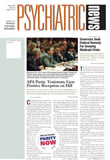The stigma that keeps parents and teens from discussing the very real symptoms of adolescent depression carries with it deadly consequences. According to the National Mental Health Awareness Campaign (NMHAC), approximately 20 percent of high school students have seriously considered or attempted suicide. Furthermore, suicide is the third-leading cause of death for people aged 15 to 24.
In an urgent effort to reduce suicide prevalence in young people and educate the public about the signs and symptoms of depression, the NMHAC launched its “Signs for Life” campaign in May.
As part of the campaign, the NMHAC has developed two tools to help prevent suicide. One is a wallet-sized card for young people containing a list of depression signs and a toll-free phone number they can call to receive counseling and information. The other is a brochure for adolescents and adults about depression and suicide in teens.
Harold Koplewicz, M.D., founder and director of the New York University Child Study Center, and Ross Szabo, director of youth outreach for NMHAC, have been promoting these tools while facilitating a national dialogue on the warning signs of depression and suicide in teens. In a media tour to kick off the Signs for Life campaign, the duo has appeared on a number of local morning news shows across the country to discuss the topic from different perspectives.
Szabo, 24, acknowledges surviving depression and a suicide attempt. He has found that by telling his story about living with bipolar disorder, he has been able to reach thousands of young people and encourage them to open up about their own experiences with mental illness.
“Many young people feel isolated and lonely because they are suffering from a mental illness like depression, or may have thoughts of suicide and don’t think there is anyone else like them,” Szabo told Psychiatric News.
In the fall of his senior year of high school, Szabo was stricken with a bout of depression that kept worsening. “I started feeling quite lonely, which was odd, since I had a number of friends and was involved in a number of school activities.” Despite these feelings, Szabo said he’d usually “put a happy face on” and not say a word to anyone about what he was feeling. Whenever he was alone each day, however, he’d cry.
By January, the feelings of loneliness and desperation reached a crescendo, and Szabo decided that he would take his life in the bathroom of his house. However, in the nick of time, his father walked by and, noting that his son was upset, asked him to come downstairs. That’s when Szabo told his parents he had planned to kill himself.
Later that year, a psychologist spoke to Szabo’s graduating class about mental illness. When he described the symptoms of mental illness, Szabo’s classmates began to laugh. “I became very angry,” he recalled. When a teacher called Szabo out into the hall to ask him what was wrong, he replied, “I have a mental illness, and I don’t appreciate people laughing.” His teacher said that his classmates were laughing because they didn’t understand mental illness and asked Szabo what he was going to do about it.
So began Szabo’s career as a spokesperson and advocate. He soon spoke to his classmates about his experiences with mental illness. Although many of them were taken aback to learn that he had a mental illness, others “came forward and said that they knew someone with a mental illness, or they had experiences similar to mine.”
The crushing lows and manic highs of bipolar disorder also followed him throughout his college years at American University in Washington, D.C., but with treatment and family support, he graduated in May.
“It is important to take away the stigma of mental illness and encourage young people to express their feelings and seek help before they get to the breaking point,” he said.
Many youth do reach their breaking points, where they feel as if there is no other option available to them but suicide—5,000 people between the ages of 15 and 24 commit suicide each year, Koplewicz pointed out.
Koplewicz complements Szabo’s perspective on mental illness with his clinical expertise. In addition to his post at the child center, he is vice chair of the department of psychiatry and a professor of clinical psychiatry and pediatrics at New York University.
“Many parents believe that adolescence is a time of angst, moodiness, and rebellion,” he told Psychiatric News. “Therefore, when a teenager’s mood changes, most parents think that change is a normal part of development.”
Koplewicz noted that “many parents aren’t ready to ask their teens the important questions about what could be symptoms of depression, or feel their children wouldn’t be receptive to that discussion.”
Parents aren’t the only ones likely to minimize symptoms of depression, however. “Most teens do not want to take medications for depression or to admit that they have very real medical illness,” he observed.
Koplewicz is the author of several books on adolescent depression. His latest book, More Than Moody: Recognizing and Treating Adolescent Depression, is scheduled to be published by Penguin Putnam Inc. in October.
Information on the Signs for Life campaign, including free wallet-sized cards and brochures on teen depression and suicide, are available by calling (877) 495-0009 or logging on to the National Mental Health Awareness Campaign Web site at www.nostigma.org. ▪
